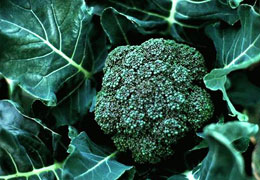


Home
Flowers &
Indoor Plants
Fruits & Nuts
Ornamentals
Vegetables
Special Topics
Resources
Glossary

Broccoli (Botrytis Group) |
 |
What about it? Broccoli is a member of the mustard family along with kale, cabbage, and radishes. It belongs to the same species and the same species group as cauliflower. It is considered a "cole crop", and is a favorite cool weather vegetable. What is it used for? The flower buds form the "head" of the broccoli plant and are edible. Broccoli is rich in vitamins A and C. Where does it grow? How do we grow it? Broccoli likes moist but well-drained soils. It requires little space and therefore makes a great vegetable for those with little gardens. However, if you do overcrowd your broccoli,'buttoning" will occur. Buttoning is the formation of small, premature heads. If you start transplants at different times, you can get two harvests? Start spring transplants indoors 5-7 weeks before the last frost. Give the fall crops 100 days before the first fall frost. What are its primary problems? Cabbageworms, cabbage loopers, and aphids could be a problem and clubroot can stunt or wilt your plants. How do we propagate it? Plant transplants 12 inches apart with 24 inches between rows. You can d i rect seed your fall crops. How do we harvest and store it? Broccoli will take about 50-70 days to mature from transplants. Pick the heads when they are full but before they have started to flower. Heads will flower quickly in warm weather. These heads should be 5 . 10 inches in diameter. After the main head is cut, smaller heads will develop on the sides. Store in the refrigerator in a paper bag.
© Copyright, Department of Horticulture, Cornell University. |

